Bringing home a new puppy? Get ready for cuteness overload… and a whole lot of training.
Because while puppies are adorable, they’re also little chaos machines—chewing, peeing, biting, and basically testing every ounce of your patience.
But don’t worry. With the right training schedule, you’ll go from frantic puppy parent to calm, confident trainer in no time.
So, let’s break it down: What should you teach your pup at each stage? From 8 weeks to adulthood, here’s your step-by-step puppy training guide.
Early Foundations (0-8 weeks)
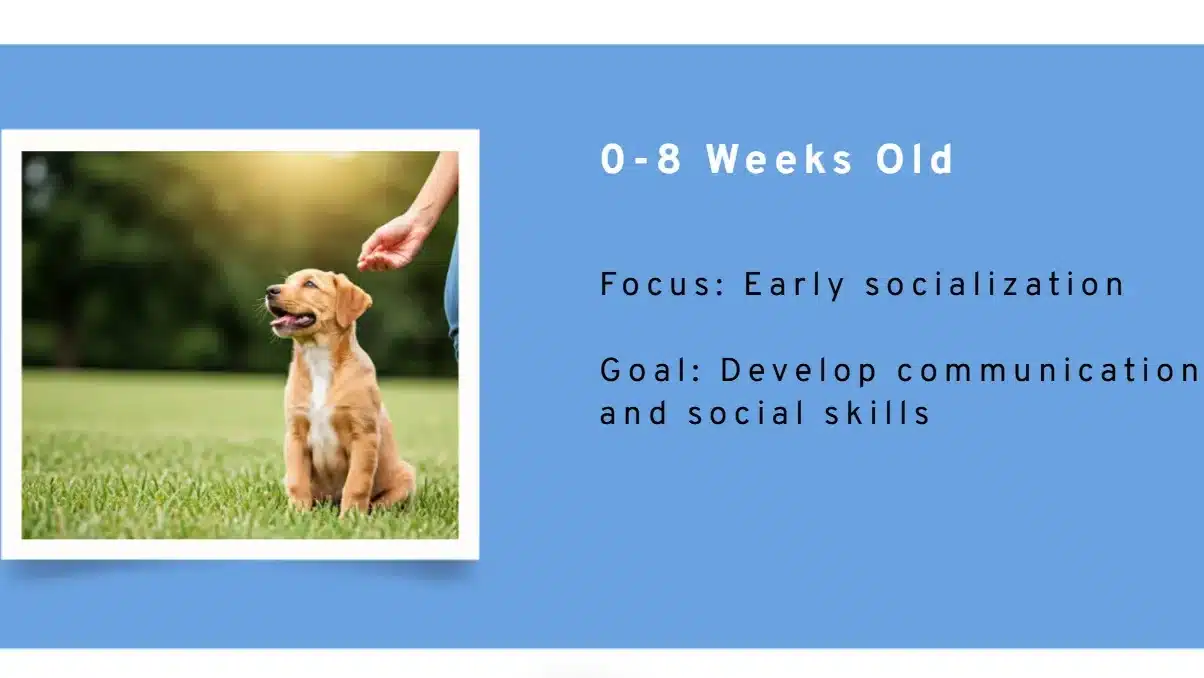
Initial Routines
During the first 8 weeks, puppies learn vital life lessons from their mother and littermates.
They pick up crucial bite inhibition skills through playful interactions and discover the basics of canine communication.
This “puppy school” with siblings teaches them how hard is too hard when playing and what different body language signals mean.
Early Socialization
Ever noticed how some puppies seem naturally more confident than others? The environment where they spend their early development weeks plays a huge role.
Quality breeders and rescue centers provide essential exposure to different sounds, textures, and gentle handling.
If you’ve adopted your puppy before 8 weeks, don’t worry! You can bridge early learning gaps by:
- Creating gentle exposure to new experiences
- Arranging supervised puppy playdates
- Using positive reinforcement consistently
- Maintaining a calm, structured environment
Remember: These foundational weeks set the stage for your puppy’s future behavior and social skills.
Initial Training (8-10 weeks)
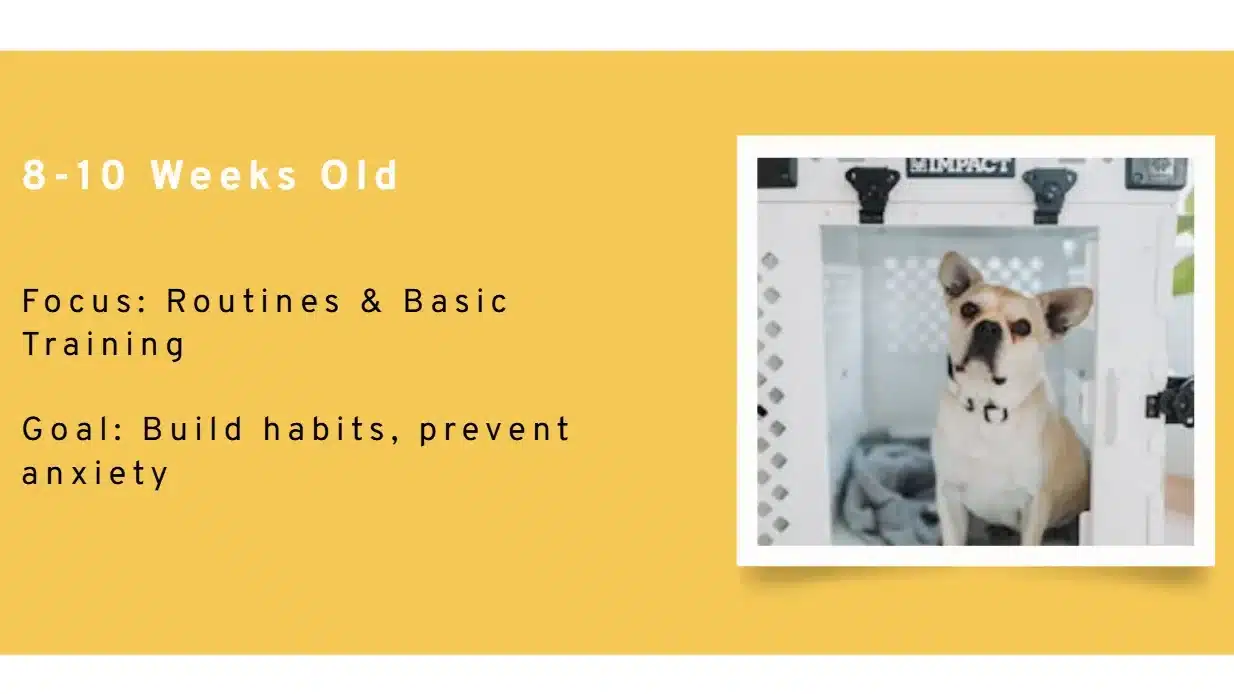
Establishing Daily Routines
This 8-10 week period is crucial for setting up habits that will last a lifetime.
So, start by creating a consistent training schedule. You can take your puppy out first thing in the morning, after meals, after naps, and before bedtime.
But remember young puppies typically need bathroom breaks every 2-3 hours.
Basic Commands and Socialization
In this period, you can also start with simple commands like “sit” and their name. Moreover, keep training sessions short – just 5 minutes at a time is enough.
Go for positive training methods to make learning fun! You can introduce your puppy to new experiences gradually:
- Short walks in quiet areas
- Meeting friendly, vaccinated dogs
- Gentle handling by different family members
- Various surfaces and textures
Crate Training Benefits
To prevent separation anxiety later by starting the crate training process now and making it a positive space by:
- Adding comfortable bedding
- Feeding meals near the crate
- Offering special toys inside
- Never using it as punishment
Note: Consistency and patience are your best friends during these formative weeks!
Socialization and Basic Commands (10-12 weeks)
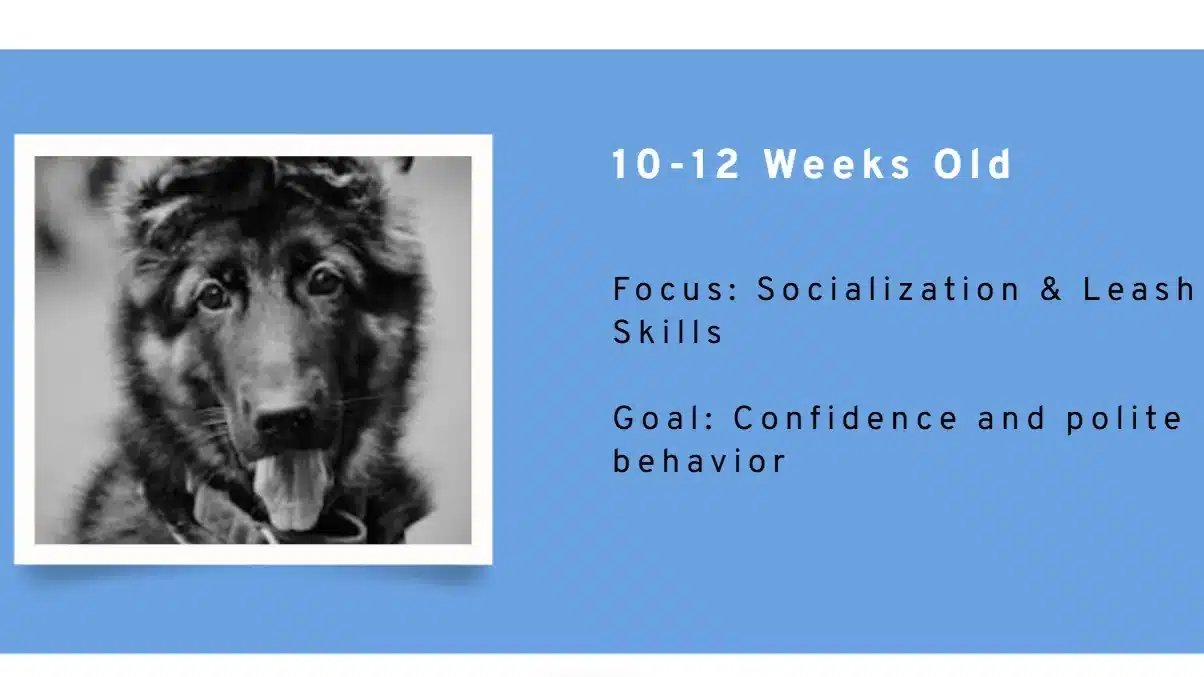
Expanding Your Training Toolkit
The 10-12 week period is perfect for introducing new commands like “come,” “down,” and “leave it.” You can reinforce these more complex behaviors with treats and praise if sessions are fun and short.
Building Social Confidence
Is your puppy ready to explore more of the world? Now’s the time to arrange supervised visits to friends’ homes and secure gardens. These controlled environments offer perfect opportunities for your pup to:
- Meet new people safely
- Experience different environments
- Practice existing commands in new settings
- Build confidence gradually
Mastering Leash Skills
The next step is to introduce a structured leash training program with proper leash etiquette.
Does your puppy pull or bite the leash? Then focus on:
- Walking beside you without pulling
- Sitting before crossing streets
- Resisting the urge to chase or lunge
- Responding to gentle leash guidance
Don’t forget to redirect attention and reward calm behaviors right now to deal with jumping and mouthing behaviors. The manners of your puppy will be influenced significantly by how you handle him in these weeks.
Advanced Socialization and Training (12-16 weeks)
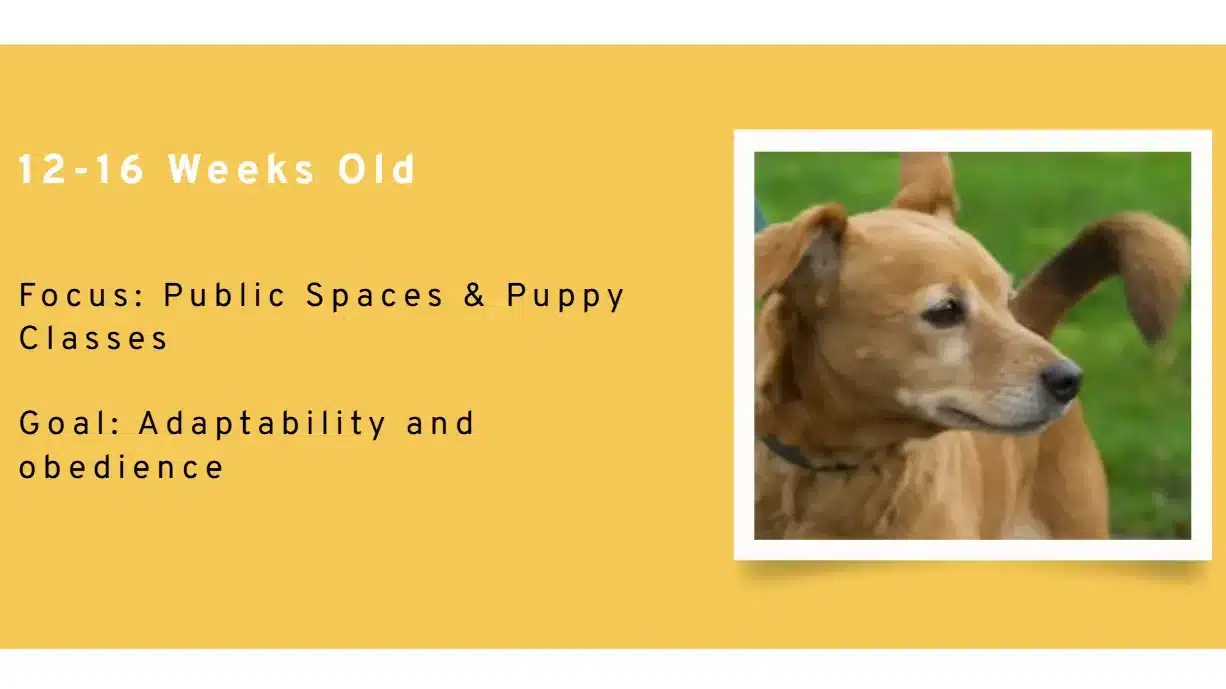
Venturing Beyond Home
At 12-16 weeks, your puppy’s vaccinations should be complete, opening up exciting new opportunities for socialization and training. Start introducing your puppy to public spaces gradually:
- Visit quiet parks during off-peak hours
- Practice short rides on public transport
- Explore pet-friendly stores
- Experience different walking surfaces
Puppy Training Classes
Have you considered joining structured puppy classes? These sessions offer invaluable opportunities for:
- Controlled interactions with other puppies
- Professional guidance for common challenges
- Learning from experienced trainers
- Building confidence in group settings
Learning Structured Walks and Greetings
The time has come for your puppy to master polite greetings. So, focus on:
- Teaching “sit” before meeting new people
- Practicing calm behavior around other dogs
- Walking nicely on a loose leash
- Maintaining focus despite distractions
Again, always keep training sessions fun and positive, celebrating small victories along the way. Your puppy’s confidence in new situations now will shape their adult behavior later!
Refining Obedience and Advanced Skills (16 weeks – 6 months)
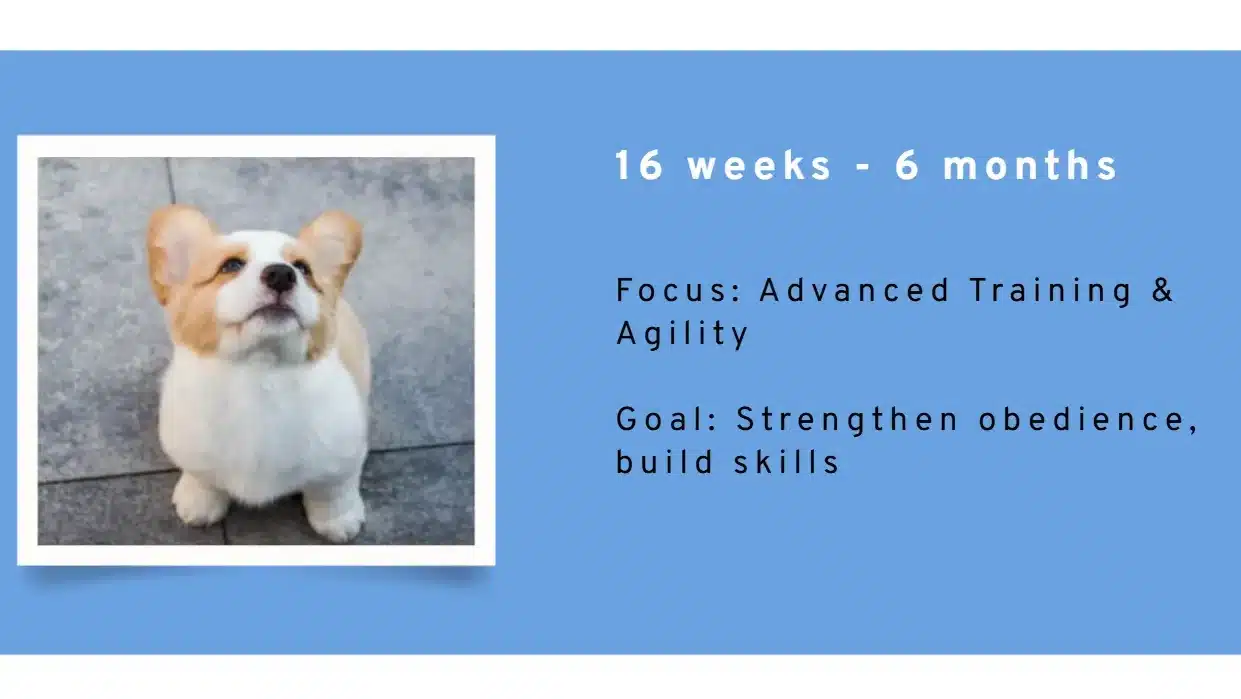
Mastering Obedience in Real-World Settings
Puppies enter adolescence around six months, which can bring a mix of excitement and challenges. Therefore, this is the perfect time to prove those basic commands in more challenging environments.
You can practice in your backyard first, then move on to parks and busy streets as you get more comfortable. Also, keep training sessions engaging by:
- Working around mild distractions first
- Using high-value treats for challenging situations
- Practicing at different times of day
- Incorporating fun agility elements
Introducing Basic Agility Work
Want to train your dog effectively mentally and physically? You can try setting up simple obstacle courses using:
- Low hurdles made from household items
- Basic tunnels for exploration
- Weaving patterns between cones
- Platform training for body awareness
Building Environmental Confidence
These adolescent puppies might test boundaries, show more independence, and display increased energy. Consider taking your pup to the following locations:
- Dog-friendly cafes
- Hardware stores
- Different parks
- Urban environments
Don’t go too long, and celebrate every little win. Your puppy’s confidence will grow as they master commands in new and exciting places!
Polite Play and Housetraining (By 6 months)
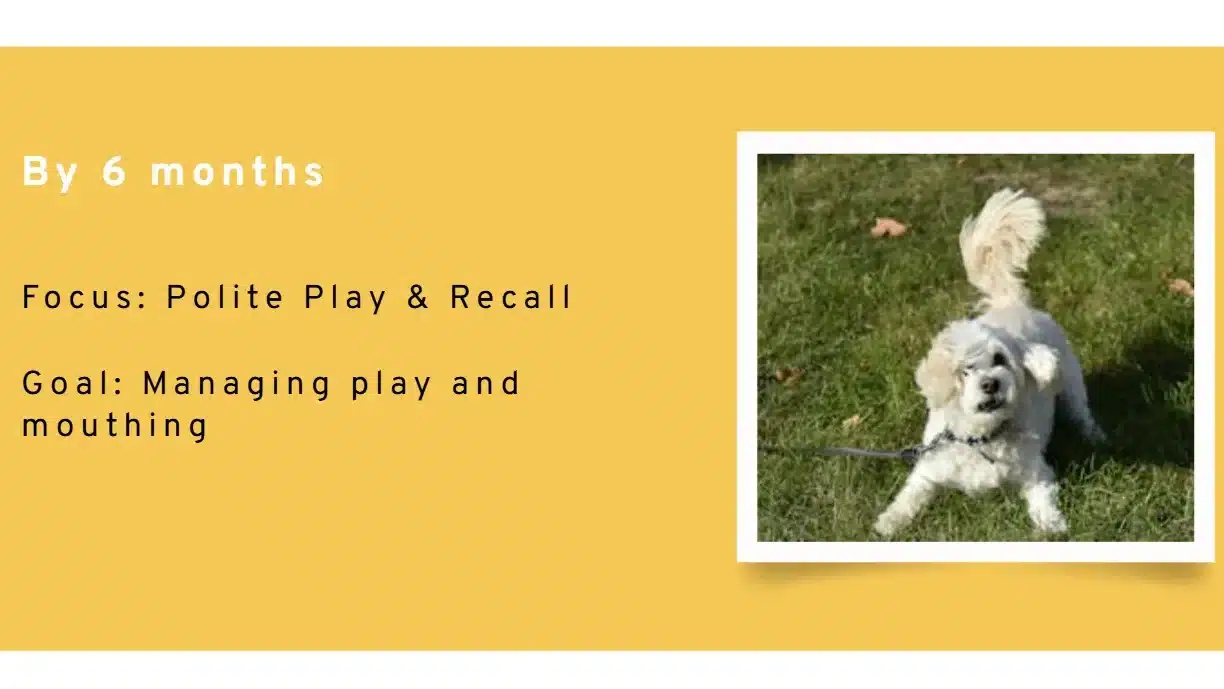
Rules of Engagement
You’ve got to get this stage right if you want lasting good behavior. When your puppy gets too excited during play, immediately pause the game and wait for calm behavior to resume.
Avoid mouthing and nipping by:
- Offering appropriate chew toys
- Using a firm “no bite” command
- Rewarding gentle play
- Ending play sessions when teeth touch skin
Continuing Housetraining Progress
Continue to work on potty habits. You should maintain a consistent training schedule and reward successful outdoor bathroom breaks. Take your pup out:
- First thing in the morning
- After meals and naps
- Before bedtime
- Every 4-6 hours during the day
Building Independence
If your puppy is comfortable being alone, you can start with short periods of separation:
- Leave the room briefly while they’re in their crate
- Gradually increase alone time
- Provide engaging toys and puzzles
- Practice “stay” commands with distance
Strengthening Recall
Make “come” their favorite word by:
- Using high-value treats
- Practicing in low-distraction areas first
- Playing recall games in the yard
- Never punishing when they come to you
Mastery of Basic Behaviors (By 1 year)
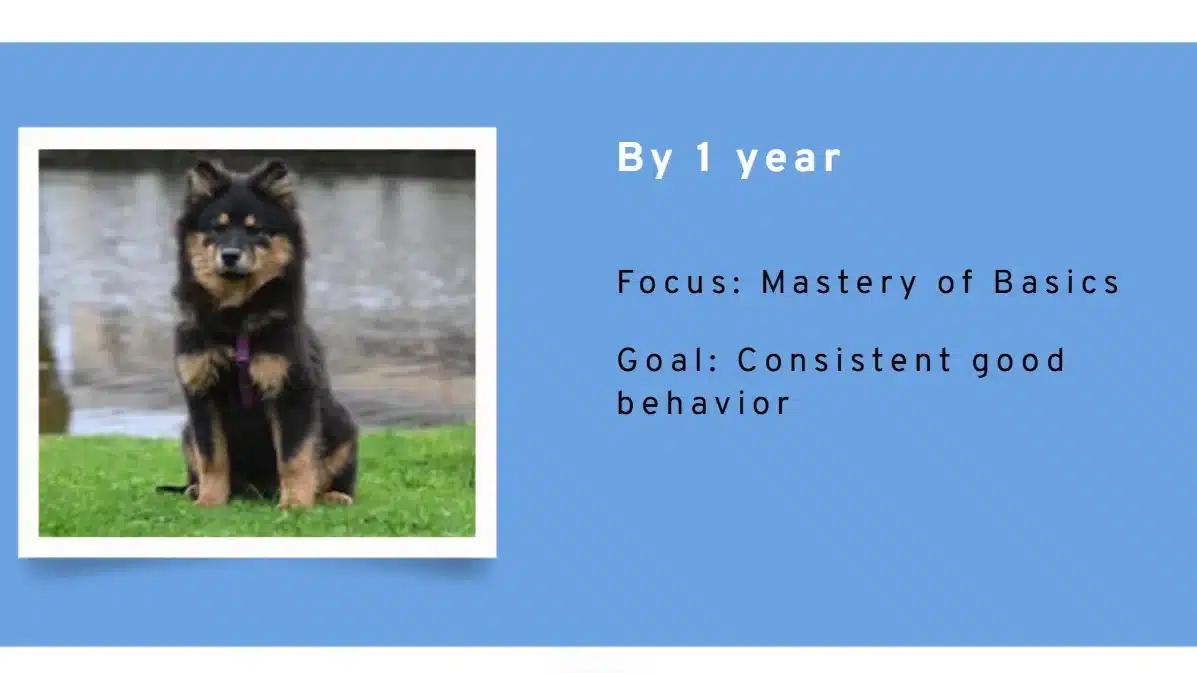
Achieving Canine Control
If your puppy mastered the basics but still struggles in challenging situations. Then by one year, your dog should reliably respond to commands even with distractions present. So, practice in increasingly difficult environments, gradually raising the stakes with:
- Other dogs nearby
- People passing by
- Interesting smells
- Outdoor noises
Smooth Loose-Leash Walking
Continue to perfect those daily walks by focusing on maintaining a relaxed leash by:
- Stopping whenever tension occurs
- Rewarding natural check-ins
- Using treats at hip level
- Practicing direction changes
Public Behavior Management
Master public behavior training by addressing:
- Excessive barking at triggers
- Greeting strangers politely
- Staying calm in crowds
- Ignoring environmental distractions
Keep training sessions positive and reward-based. When your pup maintains focus despite distractions, you’ll know they’ve truly mastered these essential life skills.
Adjusting for Older Puppies or Adult Dogs
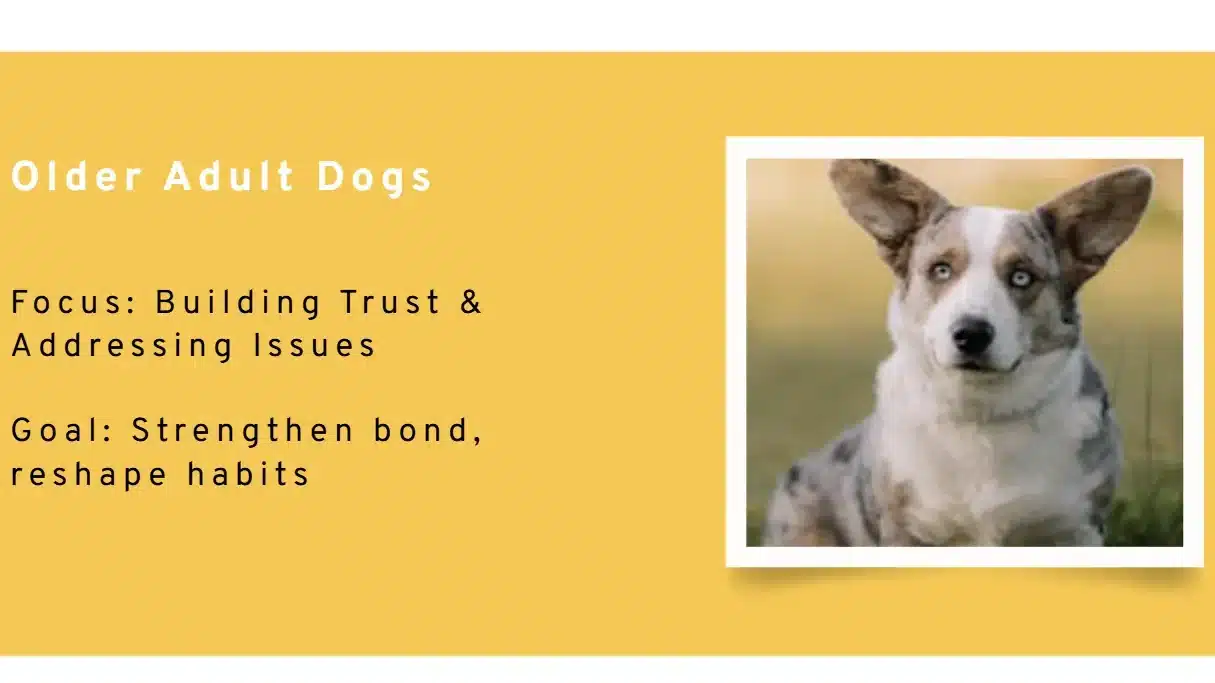
Starting a New
Have you recently adopted an older puppy or adult dog? Don’t worry – it’s never too late to establish positive training habits! Start by creating a training schedule that works for both you and your new companion.
Begin with basic commands like “sit,” “stay,” and “come,” even if your dog seems familiar with them. This helps:
- Build trust and communication
- Establish your training style
- Create consistency in responses
- Strengthen your bond
Addressing Behavioral Challenges
Is your older dog showing unwanted behaviors? Focus on positive training techniques to reshape these habits:
- Replace jumping with “sit” for greetings
- Redirect excessive barking to “quiet” command
- Transform leash pulling into loose-leash walking
- Convert mouthing into gentle play
Remember to:
- Keep training sessions short and upbeat
- Use high-value treats for motivation
- Practice in low-distraction areas first
- Celebrate small improvements
Your older dog can absolutely learn new tricks! Patience and consistency will help them transition into their new life with you.
Wrapping Up
Remember that every puppy develops at their own pace, and what works perfectly for one may need adjustment for another. The key is maintaining consistency while adapting to your puppy’s unique personality and learning style. Your patience and dedication during these developmental stages will pay dividends for years to come.
Think of this training schedule as your roadmap to success, but don’t be afraid to take scenic detours when needed. The journey of raising a well-behaved dog isn’t just about reaching destinations – it’s about building an unshakeable bond through understanding, patience, and positive reinforcement at every age.
